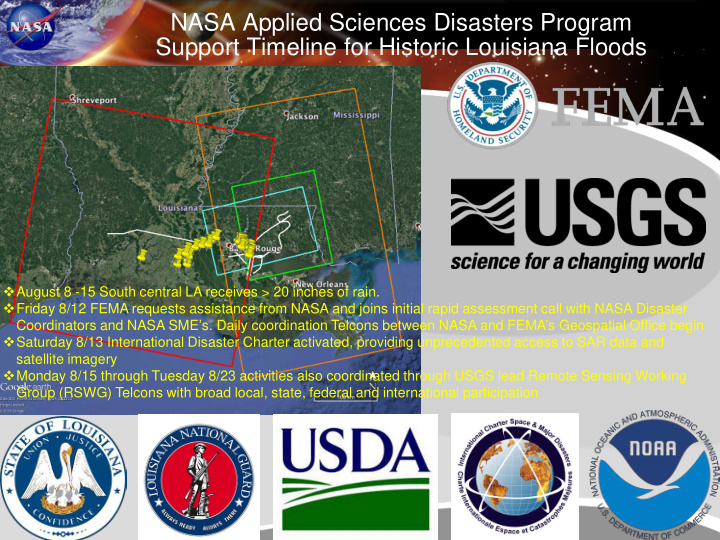



NASA Applied Sciences Disasters Program Support Timeline for Historic Louisiana Floods August 8 -15 South central LA receives > 20 inches of rain. Friday 8/12 FEMA requests assistance from NASA and joins initial rapid assessment call with NASA Disaster Coordinators and NASA SME’s. Daily coordination Telcons between NASA and FEMA’s Geospatial Office begin Saturday 8/13 International Disaster Charter activated, providing unprecedented access to SAR data and satellite imagery Monday 8/15 through Tuesday 8/23 activities also coordinated through USGS lead Remote Sensing Working Group (RSWG) Telcons with broad local, state, federal and international participation
NASA Observes Historic Rainfall in Louisiana NASA's IMERG data from Aug. 8 to Aug. 15, 2016 showed over 20 inches (508 mm) of rainfall was estimated in large areas of southeastern Louisiana and extreme southern Mississippi. Even greater rainfall totals of 30 inches (762 mm) were indicated in a small area of Louisiana west of Lake Pontchartrain. 2 Credits: NASA/JAXA, Hal Pierce
NASA Global Precipitation Mission – GPM IMERG NASA's IMERG data from Aug. 8 to Aug. 15, 2016 showed over 20 inches (508 mm) of rainfall was estimated in large areas of southeastern Louisiana and extreme southern Mississippi. Even greater rainfall totals of 30 inches (762 mm) were indicated in a small area of Louisiana west of Lake Pontchartrain. 3 Credits: NASA/JAXA, Hal Pierce
Global Flood Mapping System – GFMS Flood Detection/Intensity Satellite precipitation estimates merged (Depth above Threshold [mm]) via the GPM product are utilized as a key Input 14 August 2016 into the Global Flood Monitoring System (GFMS) utilizing land surface and routing models at 12 and 1 km resolution to estimate the occurrence and intensity of floods. The hydrological calculations are extended into the future (out to five days) using GEOS-5 rainfall predictions. GFMS-based Inundation VIIRS-based Inundation Estimate Estimate Global Flood Monitoring System (GFMS) Adler/Wu University of Maryland Inundation Estimation (1 km) 13 August 2016 During the Louisiana floods in August GFMS images and data were provided showing large-scale current conditions and forecasts as in upper left image (3-hr resolution). The forecasts were used by FEMA to help plan their response. The 1-km resolution inundation estimates from GFMS (example in lower left) were downloaded by FEMA and used to estimate number of structures and homes impacted. The GFMS inundation estimates were also used Credit: Bob Adler and Huan WU, UMD to compare with those from optical and SAR data, when 4 available (see above).
NPP Suomi VIIRS Flood Maps Overview of flooding near Baton Rouge using VIIRS 30-m flood map composited from August 15 and August 17, 2016. Light purple is water. August 15-17, 2016 VIRRS Flood maps courtesy of Sanmei Li, GMU. 5
NASA Hyperion (EO-1) Imagery August 16, 2016 15m EO-1 imagery courtesy of Stu Frye, NASA GSFC. 6
ISS Handheld Digital Camera Photography Baton Rouge, LA Amite R. • ISS USOS crew acquired imagery of flooding area on Aug 16, 17, 23 in response to target requests from JSC Crew Earth Observations ops team (example of targeting information above) • Downlinked imagery reviewed and manually georeferenced prior to delivery to USGS HDDS team ISS048-E-65146 • Data potentially useful for validation of Acquired 08.23.16 SAR and flood extent model products 500 mm lens Credit: Will Stefanov, NASA JSC
Suomi NPP VIIRS Day-Night Band Detects Power Outages VIIRS DNB Image During Flood Event, August 15 th , 2016 NASA GSFC Disaster Team utilized a new algorithm for producing night time optical data, which was used as one of the assets for assessing impact of the Louisiana floods at the request of FEMA. In this case, the data was used for determining power outages as a means of mapping impact zones. (NASA Direct Image Before Flooding, May 7 th , 2016 Readout Lab). Top-L: During flood event, Aug 15 th , 2016; Bottom-L : Before event, May 7 th , 2016. A similar product developed by NASA MSFC to difference images such as these was first provided by NASA Disasters to DHS/FEMA to support efforts to restore power after Hurricane Sandy. 8 Credit: Dalia Kirschbaum and Miguel Roman, NASA GSFC
NASA Coordinates Synchronized Space-Air-Ground Observations for Historic Floods in Louisiana Sentinel–1A COSMO-SkyMed RADARSAT–2 ALOS–2 NOAA USGS JPL coordinated synchronized observations of spaceborne SAR Photo: Dennis K. Demcheck, U.S. Geological Survey sensors, high-resolution airborne optical sensor, and field crews on the ground.
Small Number of Ground Observations Calibrate a Wide Swath Flood Map Derived from Satellite SAR Data NOAA 4-band Aerial Image Red Pixels: ARIA Flood Proxy Map Yellow Pushpins: USGS Water Edge Flooded vegetation Open water flood
Satellite SAR Data Validate Well with Ground Observations A B C A B C D D Red Pixels: ARIA Flood Proxy Map Yellow Pushpins: USGS Water Edge Positions E E Photo: Dennis K. Demcheck, U.S. Geological Survey
Questions? 12
Recommend
More recommend